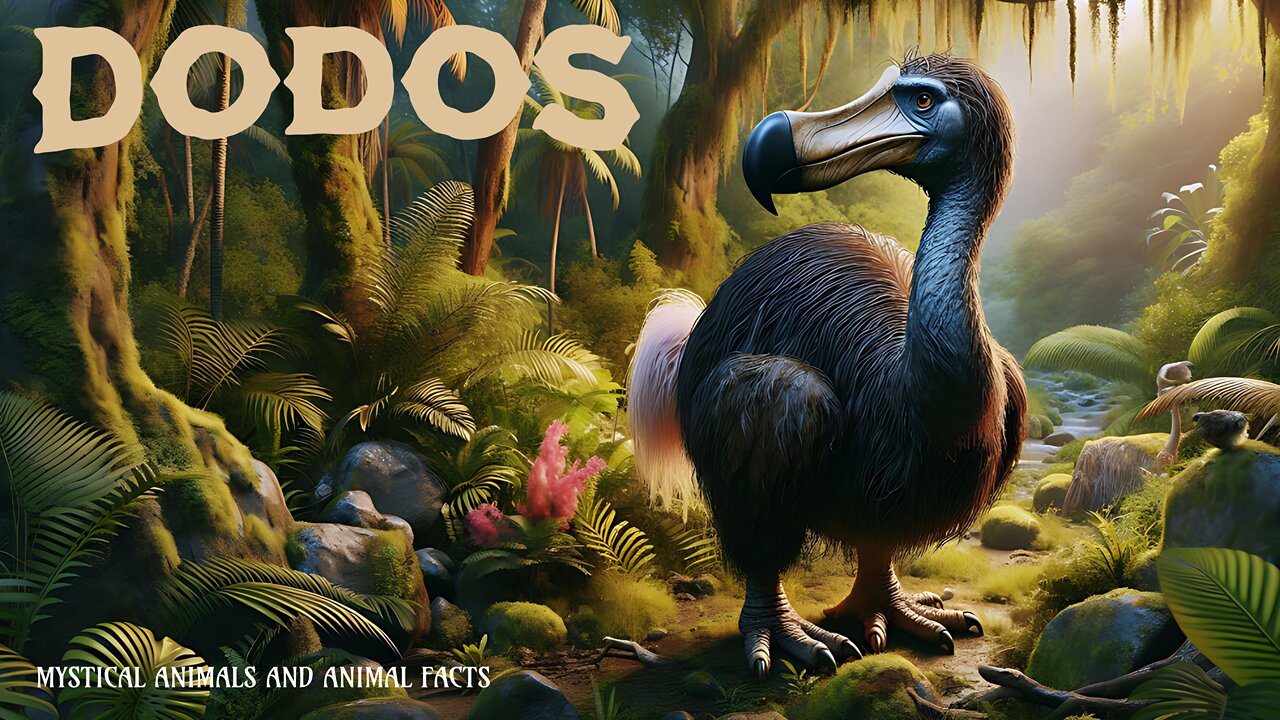Premium Only Content

The dodo - a tragedy of evolution and human intervention - mini documentary
The dodo, once native to Mauritius, is today probably the most famous symbol of human-induced extinction. This flightless bird from the pigeon family disappeared at the end of the 17th century - barely 100 years after its discovery by European sailors. Its story is a reminder of the fragility of ecosystems and the consequences of human ignorance.
The dodo evolved over millions of years in isolation on Mauritius, a volcanic island in the Indian Ocean. As there were no large predators there, the bird lost its ability to fly - a typical phenomenon in island species (island dwarfism or gigantism). Its closest relatives were pigeons capable of flight, but the lack of predators and the abundant food supply made the dodo heavy (approx. 10-18 kg) and corpulent. Its short legs, curved beak and gray plumage with white accents characterized its distinctive appearance. The early European drawings varied greatly, which made later reconstructions difficult.
The dodo inhabited the forests and coastal regions of Mauritius and fed on fruits, seeds and invertebrates. It could even crack hard nuts with its powerful beak. Scientists suspect that it played a key role in the ecosystem, for example by spreading plant seeds, including those of the tambalacoque tree. The myth that this tree almost disappeared after the extinction of the dodo is controversial, but underlines the ecological importance of the bird.
When Dutch sailors first reached Mauritius in 1598, they encountered the unsuspecting dodo. As it showed no fear of humans, it was ridiculed as “stupid” - an unjust reputation, as its behavior was evolutionary. The Dutch called it the “whale bird”, probably because of its firm flesh. Nevertheless, sailors hunted the dodo to provide themselves with fresh meat on long sea voyages. Worse still, with the Europeans came invasive species such as rats and pigs, which threatened the dodos breeding on the ground. They ate eggs and chicks, destroyed nests and competed for food.
Within a few decades, the dodo was wiped out by habitat destruction, hunting and invasive species. The last confirmed sighting date is around 1662, but isolated reports date back to 1681. As only a few specimens made it to Europe and hardly any skeletons survived, the dodo was soon forgotten - until it became a symbol of extinction in the 19th century. The most famous relic, the “Oxford dodo”, now consists of just a skull and a foot.
The dodo lives on in language and literature: the phrase “dead as a dodo” stands for its irrevocable disappearance. The bird first came to scientific attention in the 19th century when naturalists such as Richard Owen studied its anatomy. DNA studies (confirmed in 2002) show that it is related to pigeons.
Today, the dodo stands for the consequences of invasive species and uncontrolled use of resources. Its fate has inspired conservation movements and research into island ecosystems.
The dodo was no foolish victim, but a product of a unique evolution that fell prey to human greed and short-sightedness. Its story reminds us that every living thing is part of a complex web whose destruction can trigger unexpected cascades. In a time of mass extinction, the dodo is a cautionary symbol: Learning from the mistakes of the past is our duty for the future. They were certainly fascinating animals. I would appreciate a like and a subscription.
Shirts and more
Designs Redbubble
https://www.redbubble.com/people/ReneMM/shop?asc=u
Spreadshirt.at
https://www.spreadshirt.at/shop/user/renemm/?srEdit=pa#?affiliateId=1257693
Spreadshirt.com
https://www.spreadshirt.com/shop/user/renemm/?srEdit=pa#?affiliateId=11625
Shirtee.at
https://www.shirtee.com/de/catalogsearch/result/index/designer_id/112048/all_stores/
1/
Pictures
https://fineartamerica.com/profiles/rene-mitterlehner
-
 2:03:22
2:03:22
Inverted World Live
4 hours agoThe Aliens Are Underwater | Ep. 117
42.4K16 -
 2:20:24
2:20:24
Badlands Media
12 hours agoDevolution Power Hour Ep. 394: The Long Game, Media Traps, and Military Signals
58K16 -
 2:08:38
2:08:38
TimcastIRL
6 hours agoNetflix Shares TANK, Elon Says BOYCOTT After Writer MOCKS Charlie Kirk Assassination
199K142 -
 LIVE
LIVE
SpartakusLIVE
8 hours agoI'M BACK || Quads w/ The Boys
870 watching -
 9:33
9:33
Ken LaCorte: Elephants in Rooms
11 hours ago $1.24 earnedWhy Do Black Men Love Big Butts?
18.5K9 -
 2:12
2:12
From Zero → Viral with AI
1 day ago $1.35 earned🚀 AI Marketing Isn’t Just for Big Brands Anymore — Here’s Why
27.6K8 -
 9:51:58
9:51:58
Dr Disrespect
14 hours ago🔴LIVE - DR DISRESPECT - 10 WINS ON CONTROLLER - BO7 TOMORROW
302K20 -
 1:24:56
1:24:56
Glenn Greenwald
8 hours agoTrump Declares Cities as the Enemies Within; Reagan Appointed Judge Slams Trump Over Speech Crackdowns; American ER Doctor on Gaza Atrocities | SYSTEM UPDATE #524
130K91 -
 LIVE
LIVE
I_Came_With_Fire_Podcast
14 hours agoPete Hegseth and the Chamber of Standards | Digital IDs | Taiwan Chips & Salsa | CDL Crisis
308 watching -
 2:01:46
2:01:46
Adam Does Movies
13 hours ago $0.33 earnedTalking Movies + Ask Me Anything - LIVE
18.3K